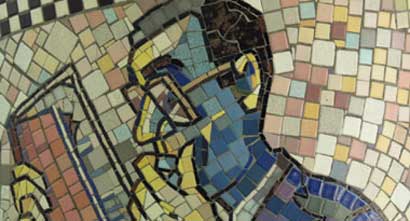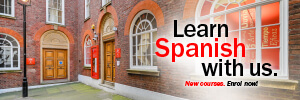Teatro y Cuentacuentos
Queridos todos:
Desde aquí queremos agradecer a Maisa y a Javier su actuación en nuestro centro. Fue una actividad muy entrañable llena de movimiento, de sorpresas OH! y de risas.
Para todos los que os acercásteis a participar en la actividad del sábado 9 de octubre, os enviamos los mejores momentos en un vídeo.
Muchas gracias por vuestra asistencia. Esperamos que os hayáis divertido !
Os recordamos que el 13 de Noviembre habrá un Taller de Arte y Cuentacuentos a cargo de Lorena Carbajal y Montse Domínguez.
Os esperamos!
El Colectivo Magazine Reading Group
El Colectivo Magazine Reading Group offers the opportunity to talk about and discuss Spanish literature, imitating the traditional Spanish tertulia.
The reading group meets one Friday per month at 6.30pm in the Instituto Cervantes; it is free to join and you are welcome to come along to any session.
In order to participate, there is only one requirement: to have read the scheduled book.
These are the titles and the dates for the last four months of 2010
Friday 17 September, 6.30pm
- El general en su laberinto by Gabriel García Márquez
Friday 15 October, 6.30pm
- Un milagro en equilibrio by Lucía Etxebarría
Friday 19 November, 6.30pm
- Abril rojo de Santiago Roncagliolo
Friday 10 December, 6.30pm
- Los informantes by Juan Gabriel Vásquez
In collaboration with El Colectivo Magazine.
For more information: grupo(at)elcolectivolondres.com
- Felix Bruzzone
- Juan Francisco Ferré
- Iosi Havilio
- Pola Oloixarac
- Sergio Olguin
Reclining male sculptures: The mesoamerican Chacmool
 ICLL Podcast series: New Episode (in English)
ICLL Podcast series: New Episode (in English)Lecture
One of the most distinctive types of Mesoamerican sculptures is that called Chacmool, representing reclining human figures holding vessels on the stomach. Chacmools have been found in Central and West Mexico as well as in the Maya region.
Elizabeth Baquedano has written several books and articles on the Aztecs, and curated an exhibition for Henry Moore’s Centenary at the University of East Anglia, Norwich. She is a lecturer at University College London, Institute of Archaeology and at the Institute for the Study of the Americas.
Young European Entrepreneur Programme
 The Young European Entrepreneur Programme is a work experience programme for graduates that encourages professional mobility and assists with the learning of other languages as stated in the policies of the European Commission. The duration of the programme is six months.
The Young European Entrepreneur Programme is a work experience programme for graduates that encourages professional mobility and assists with the learning of other languages as stated in the policies of the European Commission. The duration of the programme is six months.
The work experience is full time, in line with the companies’ own office hours. A variety of UK companies in different sectors take part every year including banks, publishers, consultancies, import/export, solicitors and real estate. These companies provide a job description in advance that is then referred to when allocating suitable candidates.
It is imperative that these descriptions give as much information as possible so that the participants can be prepared for the interviews during the first week of the programme and also so that they can be assigned to places where any existing skills will be relevant to their work.
Alongside the actual work experience the participants undertake 2-hour Business English classes held two evenings per week and ten 2-hour International Business Workshops held fortnightly in the afternoon. The language-based Business English classes have a total of 96 hours and are specially designed for this programme.
At the end of the course an exam is taken to achieve a University of Cambridge qualification (Cambridge Business English Certificate or BEC). The ten workshops cover a range of topics relating to the development of business in the UK.
Download the complete description and application forms here:
- Description of the Programme
- Application form for participants
- Terms and conditions for participants
Spanish Chamber of Commerce in Great Britain http://www.spanishchamber.co.uk
The secret history of Costaguana
 ICLL Podcast series: New Episode (in English)
ICLL Podcast series: New Episode (in English)
Book launch
London 1903, and Colombian José Altamirano has just arrived from a place he wishes to forget, shouldering a past he regrets and more guilt than anyone can carry.
He could have stopped the cession of the Panama territory, but chose not to. He then realises that Joseph Conrad is beginning to publish Nostromo, recounting a story he once related to him, and that he is being marginalised and virtually erased from that history.
Juan Gabriel Vázquez was born in bogotá in 1973 and now lives in Barcelona. His essays, reviews and reportages have appeared in various magazines and literary supplements. He was recently nominated as one of the «Bogota 39», South America’s most promising writers of the new generation.
http://londres.cervantes.es/FichasCultura/Ficha63189_22_1.htm
Marañón and Liberalism = Marañón y el liberalismo
 ICLL Podcast series: New Episode (in English)
ICLL Podcast series: New Episode (in English)
A member of the «1914 Generation» with Ortega y Gasset, and with his book Vieja y Nueva Política as his main intellectual symbol, Marañón reaches liberalism through family and friends.
It is a time of regeneration and Marañón, as a doctor and scientist, comes to public life as the President of the Ateneo de Madrid and co-founder, toghether with ortega and Pérez de Ayala, of the Association for the Service of the Republic. (In English)
Tom Burns Marañón was the Spanish correspondent for important foreign media. He is the author of a trilogy on oral history of the Transition (Conversaciones sobre el rey, Conversaciones sobre el socialismo, Conversaciones sobre la derecha, Barcelona 1995-1997)
http://londres.cervantes.es/FichasCultura/Ficha63165_22_1.htm
The Life and poetry of Miguel Hernández = La vida y la obra de Miguel Hernández
 ICLL Podcast series: New Episode (in Spanish)
ICLL Podcast series: New Episode (in Spanish)
Round Table discussion about the life and poetry of Miguel Hernández.
Participants: Rosa Navarrro, University of Barcelona & Alan Feinstein, writer & translator.
Miguel Hernández was born in Orihuela (Alicante) in 1910. His poetry is characterised by its strong lyricism, exemplified in both his first collection of poems, Perito en lunas (1933), and in his classical sonnets such as El rayo que no cesa.
His poems cover the themes of love, death, war and injustice, themes of which he had personal and intense experience. He fought with the Republicans during the Spanish Civil War.
In prison he wrote Cancionero y romancero de ausencias (published in 1958), poems dedicated to his wife who lived in miserable conditions. He died in prison at the age of 31. (In Spanish)
http://londres.cervantes.es/FichasCultura/Ficha63188_22_2.htm
Gonzalo Torrente Ballester en su centenario
 About two years ago we, at the Cervantes Institute Library, received an anonymous call offering a donation of books in Spanish.
About two years ago we, at the Cervantes Institute Library, received an anonymous call offering a donation of books in Spanish.
A mi querida amiga Elenita, a la que amo hace algún tiempo… Cuando nos conocimos a los 20 años. ¿Verdad?*
*To my darling friend Elenita, whom I have loved for quite some time … ever since we met when we were 20, true?
The poetry of Jaime Siles from 1969-2009 = La poesía de Jaime Siles
 ICLL Podcast series: New Episode (in Spanish) Jaime Siles talks about his development as a poet since 1969, discussing and reading the most representative poems of different periods of his evolution.
ICLL Podcast series: New Episode (in Spanish) Jaime Siles talks about his development as a poet since 1969, discussing and reading the most representative poems of different periods of his evolution.
Jaime Siles habla sobre su evolución poética desde 1969 hasta hoy, ilustrándola con la lectura y comentario de los poemas de diferentes épocas que considera más representativos.
Jaime Siles is an award-winning poet and critic. He is Professor of Classic Philology and has taught in various European universities. Currently, he teaches Classic Philology at the University of Valencia and is the President of the Spanish Society of Classical Studies. He also writes essays and literary criticism. Since 2005 he has written for the daily newspaper ABC. he is also a permanent member of the Royal Academy of Culture of Valencia.
Eurotoolbox launch
We have pleasure in inviting you to join us for the Exhibition Launch at the Music Library, Barbican Centre.
Wed. 23rd of June, 6:30 p.m.
![]() Download invitation
Download invitation
Eurotoolbox on the road:
a travelling exhibition of Children and Youth literature from Europe
- Five specially chosen collections for children and youth literature from Europe on display
- Panel talk with Axel Scheffler (illustrator, Germany), Paloma Bordons (writer and illustrator, Spain) and John Lake (librarian, Barbican Library)
- Refreshments and snacks will be served
Wed. 23rd of June, 6:30 p.m. Music Library, Barbican Centre. Silk Street, London EC2Y 8DS Barbican
Exhibition |
Adquisition Tools |
Selection Tools |
Who’s it for?
Public librarians (incl. children’s librarians); school librarians; ‘special’ librarians; any librarian who wants to know more about meeting users’ needs for material in western European languages. The books could be displayed in staff areas or in public areas, as you wish.
What’s in it?
Five specially chosen collections of children’s and youth literature from Europe, in the original language (French, German, Italian, Portuguese, or Spanish, between 12 and 15 books in each language). The authors and illustrators selected represent some of the very best in children’s book production in these languages.
How much does it cost?
The exhibition is free to borrow. You will need to organise transportation to the next borrower yourself. The exhibition is packed into 2 boxes, total weight about 30kg.
How can I borrow it?
You can borrow the exhibition for about 2 – 4 weeks at a time. To book a time slot, please contact David Carrión at the Instituto Cervantes from the 1st of June 2010.
For more details:
![]() Download the ppt presentation
Download the ppt presentation
 Download full contents listing (PDF, 77 KB)
Download full contents listing (PDF, 77 KB)
 Download flyer (Doc, 32 KB)
Download flyer (Doc, 32 KB)
Exhibition |
Adquisition Tools |
Selection Tools |











